MSP430 ADC Sample Code
Uploaded by
Khanh NamMSP430 ADC Sample Code
Uploaded by
Khanh NamSample Code: A/D Converter for MSP430
by Brandon Cerge
The code below will continuously sample a voltage on channel A0 on the MSP430 and display the 10-bit result in 16-bit format (ie, 0x00000x03FF) on the LCD screen. See UF_LCD tutorial for wiring of the LCD screen.
#include <msp430x22x2.h> #include <UF_LCD.h> void main(void){ WDTCTL = WDTPW + WDTHOLD; DCOCTL = CALDCO_16MHZ; BCSCTL1 = CALBC1_16MHZ; ADC10CTL1 |= CONSEQ1; ADC10CTL0 |= ADC10SHT_2 + ADC10ON + MSC; ADC10AE0 |= 0x01; ADC10CTL0 |= ADC10SC + ENC; lcd_init(); lcd_char('0'); lcd_char('x'); // disable watch dog timer // set internal oscillator at 16MHz // set internal oscillator at 16MHz //continuous sample mode, MUST BE SET FIRST! //sample and hold time, adc on, cont. sample // select channel A0 // start conversions //get the lcd booted up // only need to write this once //only need to write this once
while(42){ //infinite loop (with meaning) lcd_byte((ADC10MEM >> 8) & 0x0003); //write upper byte lcd_byte(ADC10MEM & 0x00FF); //write lower byte lcd_command(0x82); //place cursor back at position 2 } }
*note: lcd_byte(char) is a function that must be written by the programmer!!
You might also like
- Program To Display Temperature in Celsius and Farenheit ScaleNo ratings yetProgram To Display Temperature in Celsius and Farenheit Scale10 pages
- Lab III: Introduction To The PIC18F4520: A. Getting StartedNo ratings yetLab III: Introduction To The PIC18F4520: A. Getting Started13 pages
- Vivekanand Education Society'S: Institute of TechnologyNo ratings yetVivekanand Education Society'S: Institute of Technology9 pages
- Write A Program For Interfacing The 16x2 LCD MODULES AimNo ratings yetWrite A Program For Interfacing The 16x2 LCD MODULES Aim7 pages
- Lab Program 12 - Analog To Digital ConverterNo ratings yetLab Program 12 - Analog To Digital Converter21 pages
- C and Assembly Code For 8051 Based Temperarture Monitoring System100% (1)C and Assembly Code For 8051 Based Temperarture Monitoring System11 pages
- Double - Dabble - 16 - Bit NBCD - Ones NBCD - Tens NBCD - Hundreds: Void Char Char Char Char100% (1)Double - Dabble - 16 - Bit NBCD - Ones NBCD - Tens NBCD - Hundreds: Void Char Char Char Char4 pages
- Programming The MSP430 For Data Acquisition and Processing: Application NoteNo ratings yetProgramming The MSP430 For Data Acquisition and Processing: Application Note6 pages
- PIC C, Serial LCD Routines, CCS PCW Compiler PDF100% (1)PIC C, Serial LCD Routines, CCS PCW Compiler PDF4 pages
- PIC C, Serial LCD Routines, CCS PCW CompilerNo ratings yetPIC C, Serial LCD Routines, CCS PCW Compiler4 pages
- Program For ADC 0808 Connecting Temperature Sensor Using 8051No ratings yetProgram For ADC 0808 Connecting Temperature Sensor Using 805113 pages
- How Do I Use An ADC Peripheral?: HI or LO. For Example, The Button Is Pushed and TheNo ratings yetHow Do I Use An ADC Peripheral?: HI or LO. For Example, The Button Is Pushed and The37 pages
- Adaptive Systems - Problem Class 5: The Leaky LMS AlgorithmNo ratings yetAdaptive Systems - Problem Class 5: The Leaky LMS Algorithm2 pages
- KEY WORDS: Athletes, Preparatory Activities, Maximum Dynamic StrengthNo ratings yetKEY WORDS: Athletes, Preparatory Activities, Maximum Dynamic Strength1 page
- Adaptive Systems - Problem Class 4: The LMS AlgorithmNo ratings yetAdaptive Systems - Problem Class 4: The LMS Algorithm2 pages
- Chapter4 (2W) - Signal Modeling - Statistical Digital Signal Processing and ModelingNo ratings yetChapter4 (2W) - Signal Modeling - Statistical Digital Signal Processing and Modeling137 pages



































































